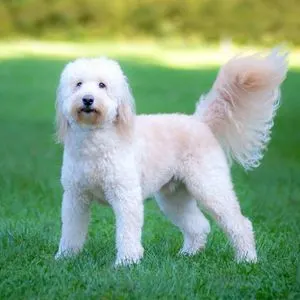The Goldendoodle’s charm continues to captivate hearts across the USA, and as breeders strive to outdo one another, we’re seeing even more variations of this beloved pup. A prime example is the English Goldendoodle, often referred to as the English Cream Goldendoodle.
This cream-colored variation is stealing the spotlight, with breeders touting its superior health, temperament, and trainability compared to the American Goldendoodle.
But how true are these claims? Is the English Cream Goldendoodle genuinely distinct from its American cousin, or is this just a clever marketing strategy to hike up the already steep price of Goldendoodles?
Let’s dive into the world of the English Cream Goldendoodle. We’ll explore what sets them apart as the “English Cream” variety, how they differ from the American version, and what characteristics they share. Join us
What is an English Goldendoodle?
An English Goldendoodle, goes by a few different names. It has also been called an English Cream Goldendoodle, an English Teddy Bear Goldendoodle or a European Goldendoodle.
Regardless of the name the English Goldendoodle is a crossbreed between a cream or white poodle and an English Golden Retriever.
The English Golden Retriever also goes by a few different names including the British Golden Retriever, an English Cream Golden Retriever or a European Goldendoodle Retriever.

Quick Facts About the English Cream Goldendoodle
| Breeding Mix: | Part English Golden Retriever and Poodle |
| Sizes: | Teacup or petite, mini, medium and standard |
| Height | 8 and 23 inches tall at shoulder |
| Weight | 7 to 120 pounds |
| Lifespan | 11 and 14 years depending on size |
| Traits | Social, outgoing, playful and intelligent |
| Colors | Cream, light apricot, light golden, patterns may include Parti, or Tuxedo |
| Training | Easy to train with proper guidance |
| Maintenance | High maintenance. Daily grooming is required. |

What is the difference between the English and American Goldendoodle?
The primary difference between a Goldendoodle and the English Goldendoodle is the type of Golden Retriever that is used in breeding.
The English Goldendoodle is bred using a British Golden Retriever, while the Goldendoodle we commonly see in the US is bred using an American Golden Retriever.
Golden Retriever Origins
All Golden Retrievers, including the English, American and Canadian versions, originated in Scotland from the same breeding pair. You can read about the Golden Retriever’s history and how they came to the USA here: Golden Retriever History: Behind the Breed’s ‘Unfashionable’ Past at AKC.org
While they may have all started in the same place, the English, American and Canadian Golden Retrievers developed differently. This is due to the breeding standards used in each country and breeders following what the public wanted.
American Golden Retriever
Overall the American Golden are a little bit taller and leaner than their European counterparts. Their eyes are almond shaped and at a slight slant.
The official colors of the American Golden are light gold, golden and dark gold. These colors are closer to the original Goldens that were bred in Scotland. Neither white or cream colored Goldens are recognized by the American Kennel Club.
English Golden Retriever
The name English Golden Retriever is inaccurate, since the English-style Golden Retrievers can also be found in Scandinavia, on the European continent, in Australia, New Zealand, and Canada.
The British or English-styled Golden Retriever stands a little shorter and has a stockier build than the American Golden. Their heads have a boxy shape and their eyes are round.
They also tend to be bred in a lighter array of colors ranging from cream to light gold to golden. But you can still find them in the darker golden colors too. Especially in field bred Goldens.
Unlike the American Kennel Club which does not recognized cream as an acceptable Golden color, the Golden Retriever Club of the UK started to recognize the cream color in 1936, mainly due to the public’s favorable opinion of them.
However, the current United Kingdom Kennel Club Breed Standard for the Golden, states “Body color that approaches cream or red is undesirable”. The UKC also does not recognize white colored Golden Retrievers.
Even though both the American and UK Kennel Clubs find cream colored Goldens undesirable, the general public loves them, therefore you can find the cream color in the American, English and European versions.
Take a look at the comparison chart below to see the differences in the breeding standards for the English and American Golden Retrievers.

Golden Retriever: English vs American Differences
| English Goldendoodle | American Goldendoodle | |
| Eyes | Brown, round and level | Dark to medium brown, slanted |
| Skull | Broad and slightly arched | Narrower profile that blends into the skull |
| Muzzle | Wide, Powerful and deep | Straight profile |
| Eyes | Round, level eyes | Almond shaped, slightly slanted |
| Ears | Level with eyes | Well behind and just below eyes |
| Height | Male 22-24″, Female 21.5- 22.5″ | Male 23-24″, Female 21.5-22.5″ |
| Coat | Shorter, wavy coat | Longer, wavy coat |
| Tail | Level with back | Level or with some curve. |
| Colors | Cream to gold | Light golden, golden and dark golden |
There are more differences between the two types of Goldens then just their physical traits. Keep reading to find out what they are.
1. Breeding
The English Cream Goldendoodle is bred using a light-colored English Golden Retriever and a white or cream-colored poodle. However, the English Goldendoodle can be bred in other colors.
And just like with their American counterparts they come in different doodle generations.
Generation Classifications
Goldendoodle Generation classifications are just an easy way to indicate how they were bred.
Here is a quick overview of what they mean.
- A F1 Goldendoodle is 50% Poodle and 50% Golden Retriever.
- If you mate a F1 Goldendoodle with a poodle you get an F1B Goldendoodle. This would give you a dog that is approximately 75% poodle and 25% Golden.
- Or you can mate an F1 Goldendoodle to a Golden Retriever. This combination is still called an F1B, but its genetic makeup should have more Golden genes than poodle genes. Generally, this means more shedding but less maintenance.
- If you mate two F1B Goldendoodles they are called a multigen doodle.
The percentage of breeds indicated above is just an estimate. Nature does what it wants. There are no guarantee which genes are handed down to the off-spring. Only that each parent contributes half the genes.
Here is a visual chart of the Doodle generation classifications.

2. English Goldendoodle Sizes
Both the English Goldendoodle and the American Goldendoodle can be found in four sizes; Petite or Tiny, Mini, Medium and Standard. However, the actually sizes within the ranges are not exactly the same.
In general, the size classifications of the doodle are dictated by the size of the poodle. Hence a standard Goldendoodle is breed using a standard poodle. A mini poodle is used for a mini doodle. For medium sized doodles a breeder may choose to use a Moyen poodle or a larger mini poodle. Petite goldendoodles are typical bred using a toy poodle and a small mini doodle.
As you view the chart below you will notice that the size ranges for the English Goldendoodle overlap. Since they do not have a specific breed standard, breeders choose the sizes and labels that best fits them and their dogs.
English Goldendoodle Size Chart
| Size Range | Height Range | Typical Weight Range |
| Petite/Tiny | Below 10 to 16 inches to shoulder | 12 to 25 lbs. |
| Miniature | Over 16 but under 19 inches at wither | 18-45 lbs. |
| Medium | Over 17 but under 21 inches at wither | 35-50 lbs. |
| Standard | Over 21 inches at wither | 51 or more lbs. |
3. English Goldendoodle Temperament
Much like the American Goldendoodle, the English version loves people, is eager to please and is highly intelligent. These characteristics make them easy to train. They also have playful personalities and can border on being goofy. Goldendoodles will continue to act like a puppy long after their first birthday.
Since both parent breeds are water retrievers, the Goldendoodle is an active dog, that likes to spend time outdoors with their families. As long as they are introduced to the water at an early age, most Goldendoodles will learn to love it.
English Goldendoodles are believed to be calmer than their American counter parts. This may have something to do with the shorter, stocky build of the English Golden Retriever. But proper breeding and exercise will go a long way in having a calmer dog.
While all Goldendoodles have great temperaments, you may see a difference in temperament based on the size doodle you choose.
- When properly socialized the standard and medium sized Goldendoodles will be confident, friendly dogs that gets along with kids and other animals.
- The smaller Goldendoodles may be more active than their larger counterparts. They may also have more fear related issues due to their small size. But they can be just as friendly, as long as they have been properly socialized.
The downfall of this very social breed is that they don’t like to be alone. Long stretches of alone time may lead to separation anxiety. This could then turn into unwanted behaviors like crying or destructive chewing.

4. English Goldendoodle Trainability
With the right motivation the English Goldendoodle is easy to train. All Goldendoodles are intelligent, social dogs that want your approval. Plus, they tend to be very food oriented.
As long as you are consistent with your commands, train often, and give them tasty treats as an award, your Goldendoodle will learn quickly and can be easily potty trained.
They do not like to be scolded though. Using negative reinforcement with your Goldendoodle will most likely backfire. It will just result in a dog that is scared of people.
If this is your first puppy consider taking training classes with your dog to learn the right way to train them.
5. Is the English Goldendoodle Hypoallergenic?
One of the things that brought doodles to the public’s attention was the claim that poodle mix breeds are hypoallergenic and don’t shed.
The belief was that since the Poodle doesn’t shed much, neither would a poodle mix-breed. For the most part this can be true, but not always.
First generation poodle mix breed will generally shed less than a purebred Golden. But once you get passed the F1 generation it becomes harder to predict if a doodle will shed or not, simply because you don’t know which genes are passed down.
In recent years, the genes that contribute to shedding have been identified allowing breeders to a make educated guess on which pairings will result in low-shedding dogs.
If you choose a breeder that does this kind of testing you will have a better chance of getting a low-shedding dog. But nothing is guaranteed.
So, what about pet allergies?
Pet allergies are believed to be caused by proteins that are found in a dog’s skin cells, saliva or urine. Most dog allergies are triggered by exposure to dander when a dog sheds. Dog dander is a small piece of skin that’s attached to the end of each hair.
Since Goldendoodles can be bred to shed less, there is less exposure to the proteins.
However, this does not guarantee that you will not be allergic to an English Goldendoodle. There are other ways that people can come in contact with the protein.
Some of the ways are:
- Being licked by the dog
- Petting them,
- Brushing them
- Cleaning up after them
It is best to spend some time around your future puppy to see if you will react.
Tip: While researching for this post, I came across a Goldendoodle breeder that would send a t-shirt that was wore by the puppy to a potential buyer to see if they would have an allergic reaction. They claimed to have a very high success rate doing this.

6. English Goldendoodles Colors
The English Goldendoodle can come in wide range in colors. They can potentially be any of the colors the Golden Retriever or Poodle comes in. See the chart below.
The English Cream Goldendoodle only comes in white or cream, hence the word cream in their name. But that doesn’t mean the English Cream Goldendoodle is different from an English Goldendoodles. They are two of the same. It’s just that one is bred specifically to have a light-colored coat.
Both the American and English Golden Retrievers can come in colors ranging from cream, light gold, golden, darken golden and even reds.
Just because a Golden Retriever is white or cream in color does not automatically make them from European stock. American Golden Retrievers can also be cream, just as English Goldendoodles come in darker shades of golden.
Goldendoodle Color Chart
| Golden Retriever Coat Colors | Poodle Coat Colors |
| Cream | Cream |
| Apricot | Apricot |
| Light Golden | Red |
| Golden | Black |
| Dark Golden | Chocolate (dark brown) |
| Reds | Silver |
| Gray |
7. Goldendoodle Maintenance
The Goldendoodle, regardless of which country they are from are high maintenance dogs. Not only do they have high grooming requirements, they are also have a lot of energy in their first few years of life.
If anyone tells you otherwise they are either not properly caring for their dog or they are lying.
8. Goldendoodle Grooming Requirements
All doodles with a wavy or curly coat will need to be groomed every six to eight weeks. Depending on the size of your dog, where you live and the condition of the coat, professional grooming can cost between $50 for a small doodle up to $200 for a standard sized doodle.
The only exception are Goldendoodles that inherit the Golden’s straight silky coat. But then, they are prone to shedding.
In addition to frequent haircuts, your doodle will need to be brushed every few days to keep the mating at bay. Of course, all this grooming also means that they will have even less hair to shed.
You can choose to groom your doodle yourself. The cost to buy the required grooming equipment is between $200 to $1000. With doodle haircuts for a large dog costing over $100 in some areas, you will recoup the money in no time.

9. English Goldendoodle Exercise Requirements
English Goldendoodles are active dogs that take time to mature. This means your English Goldendoodle will act like a puppy and have all that puppy energy for longer than other breeds.
As descendants from hunting breeds, Goldendoodles are happiest when they are outside and moving. But they don’t want to be alone.
Daily exercise that includes a couple of 30 to 45-minute walks and fun games of fetch should keep them calm. Goldendoodles that do not get enough exercise or are left alone for long periods of time can become destructive or bark excessively.
But remember all dogs are different, if your dog starts to get into trouble they probably need more exercise.
10. Goldendoodle Health
Goldendoodles are an overall healthy breed but Golden Retrievers suffer from a high rate of cancer.
A health report that was published by the Golden Retriever Club of America (GRCA) in the late 1990’s, identified cancer as the cause of death in 61.4 percent of their dogs.
However, the cancer risk in European-bred Goldens appears to be much lower. A 2010 study put the death rate at 38.8 percent. Although much higher than other breeds, the rate of cancer is substantially lower than that found in North American Goldens.
Since the English Goldendoodles can develop health conditions that are common to both the Golden Retriever and Poodle, they are more susceptible to getting cancer.
Here are some more health conditions that can affect the Goldendoodle.
Health concerns include:
- Ear Infections – This is due to their long hairy ears that can reduce air flow and increase moisture that can cause infections
- Sebaceous adenitis – Skin disease
- Hip dysplasia – This is a condition in which the thigh bone becomes displaced from the hip joint. There is a strong genetic component with this condition, which can be avoided through genetic testing
- Subvalvular Aortic Stenosis – A disease which causes a narrowing at the aortic valve of the heart
- Addison’s disease – Also known as hypoadrenocorticism, this disease decreases hormone production from the outer part or cortex of the adrenal gland
- Various eye diseases – Common eye diseases include progressive retinal atrophy, cataracts and glaucoma
- Von Willebrand’s disease – a blood condition that affects clotting
- Gastric dilatation-volvulus (GDV) also known as Bloat – this is a common condition in both the poodle and Golden Retriever. GDV occurs when a dog’s stomach fills with gas, food, or fluid and subsequently twists
To minimize the risk of getting a dog with health issues, ask the breeder for proof of health testing on both the parents.
Possible Health Testing includes:
- Hip certifications from the Orthopedic Foundation for Animals,
- OFA heart clearance
- Certification from the Canine Eye Registry Foundation that the eyes are healthy
- An OFA elbow clearance for standard Goldendoodles,
- An OFA knee clearance for small or medium-size Goldendoodles
- A DNA test for progressive retinal atrophy
11. Goldendoodle Lifespan
Life expectancy will depend on the size of your doodle and breeding. The average Goldendoodle’s lifespan is between 11 and 14 years. But small Goldendoodles can live longer.
12. Goldendoodle Costs
English Goldendoodles are expensive dogs. The cost to purchase one ranges between $1,200 up to $10,000.
Cost will depend on where you get them from, if the parents were health checked, the size category and if they are trained. In many cases a mini Goldendoodle will cost more than a standard doodle.
In the lower range you will find puppies that are not health checked. An untrained English Goldendoodle puppy whose parents were health testing and passed, will range between $3,500 and $5,000.
At the higher range of $8,000 to $10,000 you will find older puppies that have been trained.
What is the difference between an English Goldendoodle and a Goldendoodle?
Most of the differences between the English and American Goldendoodle are in appearance. The English Goldendoodle tends to have a lighter coat, stockier build and a little less energetic. American Goldendoodles are typically darker in color, slightly taller and slender, with a more active personality.
English Cream Goldendoodle Resources:
- Golden Retriever History: Behind the Breed’s ‘Unfashionable’ Past – AKC.org
- British-Style Golden Retrievers Today. – By Michele Gawenka, with Marcia Schlehr
- The United Kingdom Kennel Club – Golden Retriever Breed Standard
- American Kennel Club – Golden Retriever Breed Standard
- Cancer in Dogs: A Large-Scale Study Offers Hope by Jane Brackman, PhD @ thewildest.com
- English Cream Golden Retrievers – Golden Retriever Club of America
- United Kingdom Golden Retriever Club Breed Standards
